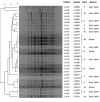Faecal shedding and strain diversity of Listeria monocytogenes in healthy ruminants and swine in Northern Spain
- PMID: 19133125
- PMCID: PMC2651128
- DOI: 10.1186/1746-6148-5-2
Faecal shedding and strain diversity of Listeria monocytogenes in healthy ruminants and swine in Northern Spain
Abstract
Background: Listeria monocytogenes is among the most important foodborne bacterial pathogens due to the high mortality rate and severity of the infection. L. monocytogenes is a ubiquitous organism occasionally present in the intestinal tract of various animal species and faecal shedding by asymptomatically infected livestock poses a risk for contamination of farm environments and raw food at the pre-harvest stages. The aim of this study was to determine the prevalence and strain diversity of L. monocytogenes in healthy ruminants and swine herds.
Results: Faecal samples from 30 animals per herd were collected from 343 herds (120 sheep, 124 beef cattle, 82 dairy cattle and 17 swine) in the Basque Country and screened in pools by an automated enzyme-linked fluorescent immunoassay (VIDAS) to estimate the prevalence of positive herds. Positive samples were subcultured onto the selective and differential agar ALOA and biochemically confirmed. L. monocytogenes was isolated from 46.3% of dairy cattle, 30.6% beef cattle and 14.2% sheep herds, but not from swine. Within-herd prevalence investigated by individually analysing 197 sheep and 221 cattle detected 1.5% of faecal shedders in sheep and 21.3% in cattle. Serotyping of 114 isolates identified complex 4b as the most prevalent (84.2%), followed by 1/2a (13.2%), and PFGE analysis of 68 isolates showed a highly diverse L. monocytogenes population in ruminant herds.
Conclusion: These results suggested that cattle represent a potentially important reservoir for L. monocytogenes in the Basque Country, and highlighted the complexity of pathogen control at the farm level.
Figures



References
-
- SIMCAPV Informe 2006. Sistema de Información Microbiológica de la Comunidad Autónoma del País Vasco. 2006.
Publication types
MeSH terms
LinkOut - more resources
Full Text Sources
Medical

